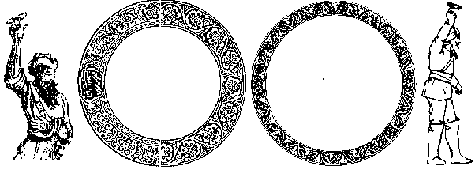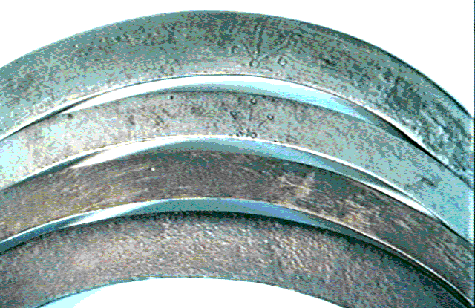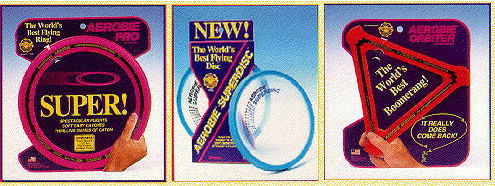The Chackrum (or Chackra) is a metal ring that has been used as a throwing weapon by the Sikhs of India for hundreds of years. The Sikhs became martial under Guru Govind Singh and used the Chackra effectively against the Moghul dynasty. The Chackrum has a history that is as old as Indian civilization itself. It's useage is embedded in Indian myth and legend. In the epics..the Mahabharata for instance...an asura trying to get heavenly nectar from the moon had his head chakra-ed off. Still he tries to swallow the moon and succeeds ever so often before the moon escapes through the cut neck...an eclipse myth. Sculptures and paintings of many gods and godesses show the chakra being twirled.
"In my youth there were people who practiced with different versions and sizes...twirling. throwing overhand and underhand. In the thrities and forties street thugs threw little chakras overhand and underhand in Calcutta." - Joy Chaudhuri
A small Chackrum is called a Quoit. The following illustrations show how the Quoit is thrown and how it can be ornately decorated. Sometimes the Quoit is inlaid with Silver or Gold. Often it is plain or with small incised decorations. The Quoit was often worn as part of a warrior's armour for decorative purposes.

The Quoit is generally 6 to 8 inches in diameter. It has a razor sharp edge and was thrown by twirling it around the warrior's index finger which was tucked in for the release. The Quoit was accurately thrown 60 to 100 metres. Two forms of the weapon existed. Chakkar Sada had a smooth and sharp outer edge. Chakkar Katavdar had a serrated outer edge. For a more in-depth essay on the use of Chackra in India, go to the Thrower Chackra page.
References about Chackrum include:
1) A Glossary of the Construction, Decoration and Use of Arms and Armour By George C. Stone
ISBN 0-517-065878
2) The Complete Encyclopedia of Arms and Weapons Edited by Leonid Tarassuk and Claude Blair ISBN 0-517-48776-4
3) Indian and Oriental Armour by Lord Egerton of Tatton, London, England, 1896
4) Studies in Indian Weapons and Warfare by G. N. Pant; Army Education Stores, India
I have four old Chackrum in my collection. They are not ornately decorated as illustrated above. They are physically much larger than the quoted 8" diameter. The smallest ring has an outer diameter of 9.3 inches and an inner diameter of 8.8 inches. The largest ring has an outer diameter of 10.8 inches and an inner diameter of 9.7 inches. The three smaller Chackrum are made out of steel and have sort of a triangular cross section with a razor sharp outer edge. Two appear to be made out of stainless steel and the third has a rusty scaled surface. It is still quite functional and intact. The lower surfaces are flat. The upper surfaces are curved with airfoiling. They weigh 5.5, 9.2 and 9.9 ounces. The fourth Chackrum is very unusual. It is made out of brass and appears to be a strip that was rolled into a hoop and then brazed to form a solid ring. The entire inner edge lies above the entire outer edge as though it were formed over a spherical body. The cross section is a sophisticted semi-elliptical airfoil. The brass Chackrum weighs only 4.6 ounces, yet it has the largest diameter of the four rings (see above). The brass Chackrum really sails. I have thrown it, Frisbee style for more than 100 metres and it flies straight and true. The steel Chackra fly only 40 - 60 metres.
Chackrum airfoiling technology: steel (left) and brass (right). Outer edges are on right.
Examples of Chackrum Metal Throwing Rings from India

The Snoopy Ruler is 12 inches in length.
An enlargement of the four Chackrum surfaces is depicted below.

The top two rings appear to be made out of stainless steel. A few decorative marks with circles and lines is easily seen. These marks are repeated in a regular pattern around their perimeter. The third ring is made of brass. The four ring is made out of a not-so-corrosion-resistant-steel.
When Alan Adler designed his famous Aerobie long distance throwing ring, I sent Alan the cross sections and basic dimensions of the above four ancient flying rings. Alan Adler added sophisticated airfoiling technology to his rubber and plastic rings and came up with a winner. If you haven't tried throwing an Aerobie, you should. I have thrown an Aerobie more than 250 metres. There are two different Aerobie flying rings, a flying disk and a flying triangle boomerang. They are all a lot of fun. You can find them for sale in just about any toy store for under $10 apiece.
 Flight Toys by SuperFlight, Inc.; 81 Encina
Ave.; Palo Alto, CA 94301; USA
Flight Toys by SuperFlight, Inc.; 81 Encina
Ave.; Palo Alto, CA 94301; USABack to: Primitive Technology | Ted Bailey's Home Page | Thrower Home Page